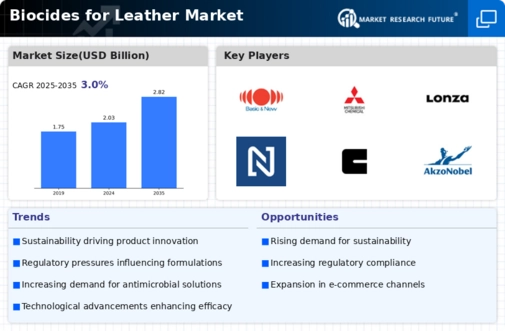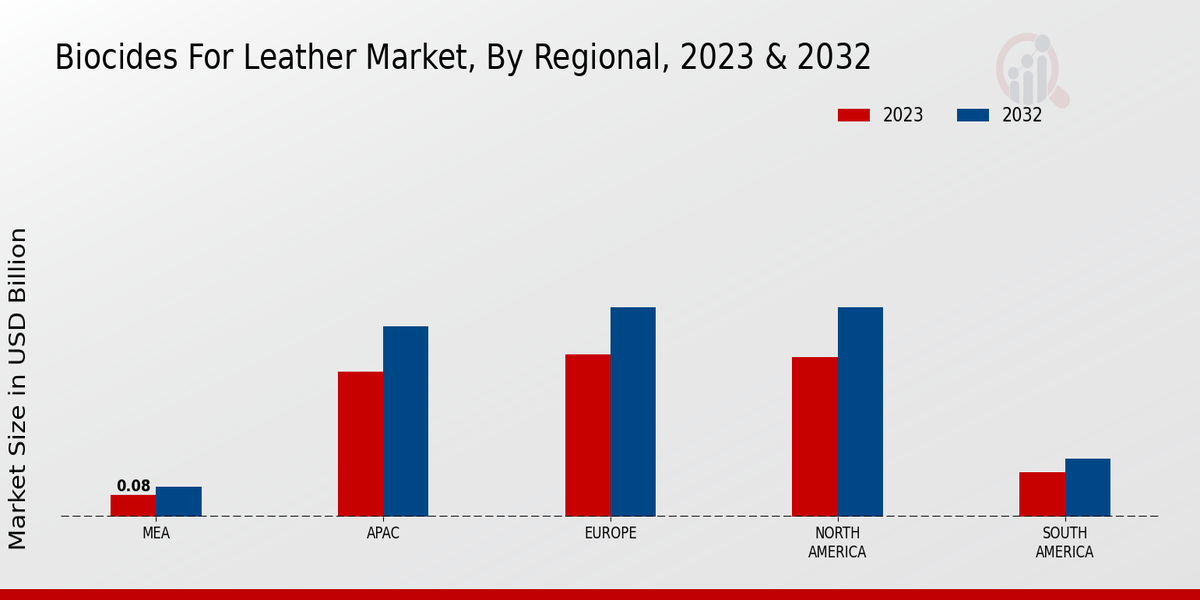Market Growth Projections
The Global Biocides for Leather Market Industry is poised for substantial growth, with projections indicating a market value of 2.82 USD Billion by 2035. This anticipated growth reflects the increasing adoption of biocides in leather processing to enhance product durability and safety. The market is expected to expand at a compound annual growth rate of 3.04% from 2025 to 2035, driven by factors such as rising consumer demand for leather goods, regulatory compliance, and technological advancements. The upward trajectory of the market underscores the critical role of biocides in the leather industry, as manufacturers seek to meet evolving consumer preferences and regulatory standards.
Growing Demand for Leather Goods
The increasing global demand for leather goods is a primary driver for the Global Biocides for Leather Market Industry. As consumer preferences shift towards high-quality leather products, manufacturers are compelled to enhance the durability and longevity of their offerings. This trend is reflected in the projected market value, which is expected to reach 2.03 USD Billion in 2024. The need for effective biocides to prevent microbial growth and deterioration in leather products is paramount, thereby propelling the biocides market forward. This demand is particularly pronounced in regions with a strong leather manufacturing base, such as Asia-Pacific and Europe.
Market Expansion in Emerging Economies
Emerging economies are witnessing a surge in leather production and consumption, which serves as a catalyst for the Global Biocides for Leather Market Industry. Countries in Asia-Pacific, Latin America, and Africa are experiencing rapid industrialization and urbanization, leading to increased demand for leather products. This expansion presents opportunities for biocide manufacturers to penetrate new markets and establish a presence in regions with burgeoning leather industries. As these markets develop, the need for effective biocidal solutions becomes critical to ensure product quality and longevity, thereby driving market growth.
Regulatory Compliance and Safety Standards
Stringent regulatory frameworks governing the use of chemicals in leather production significantly influence the Global Biocides for Leather Market Industry. Governments are increasingly enforcing safety standards to mitigate environmental and health risks associated with biocides. Compliance with these regulations necessitates the adoption of safer and more effective biocidal agents in leather processing. As a result, manufacturers are investing in research and development to formulate biocides that meet regulatory requirements while ensuring product efficacy. This trend not only enhances consumer safety but also fosters innovation within the industry, thereby contributing to market growth.
Sustainability Trends in Leather Production
The rising emphasis on sustainability within the leather industry is driving changes in the Global Biocides for Leather Market Industry. Consumers are increasingly favoring eco-friendly products, prompting manufacturers to adopt sustainable practices in leather production. This shift necessitates the use of biocides that align with environmental standards, thereby influencing purchasing decisions. Companies that prioritize sustainability are likely to gain a competitive edge, as they cater to the growing market segment that values ethical sourcing and production methods. This trend not only enhances brand reputation but also contributes to the overall growth of the biocides market.
Technological Advancements in Biocide Formulations
Innovations in biocide formulations are reshaping the landscape of the Global Biocides for Leather Market Industry. Advances in technology enable the development of more effective and environmentally friendly biocides, which are crucial for leather preservation. These innovations often lead to improved performance characteristics, such as enhanced antimicrobial efficacy and reduced toxicity. As manufacturers seek to differentiate their products in a competitive market, the adoption of advanced biocidal solutions becomes essential. This trend is expected to sustain market growth, with projections indicating a compound annual growth rate of 3.04% from 2025 to 2035, further solidifying the industry's trajectory.



 Source: Primary Research, Secondary Research, MRFR Database and Analyst Review
Source: Primary Research, Secondary Research, MRFR Database and Analyst Review














